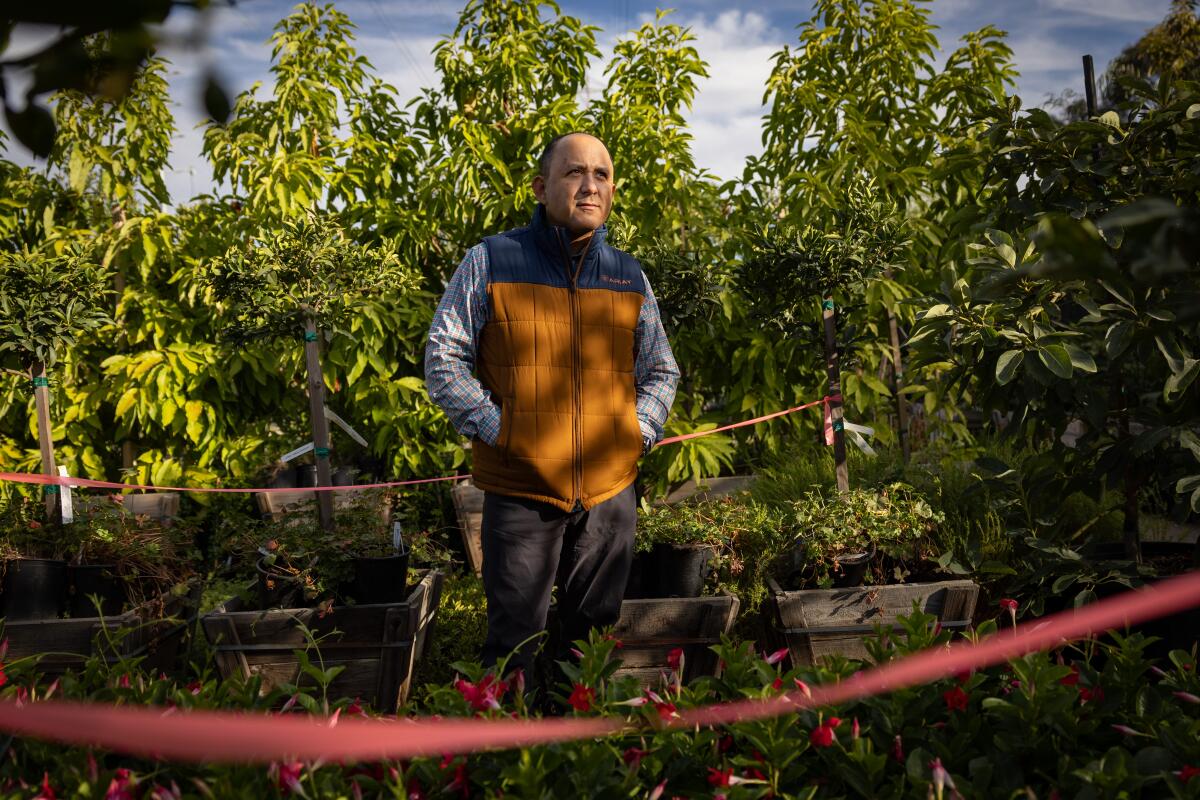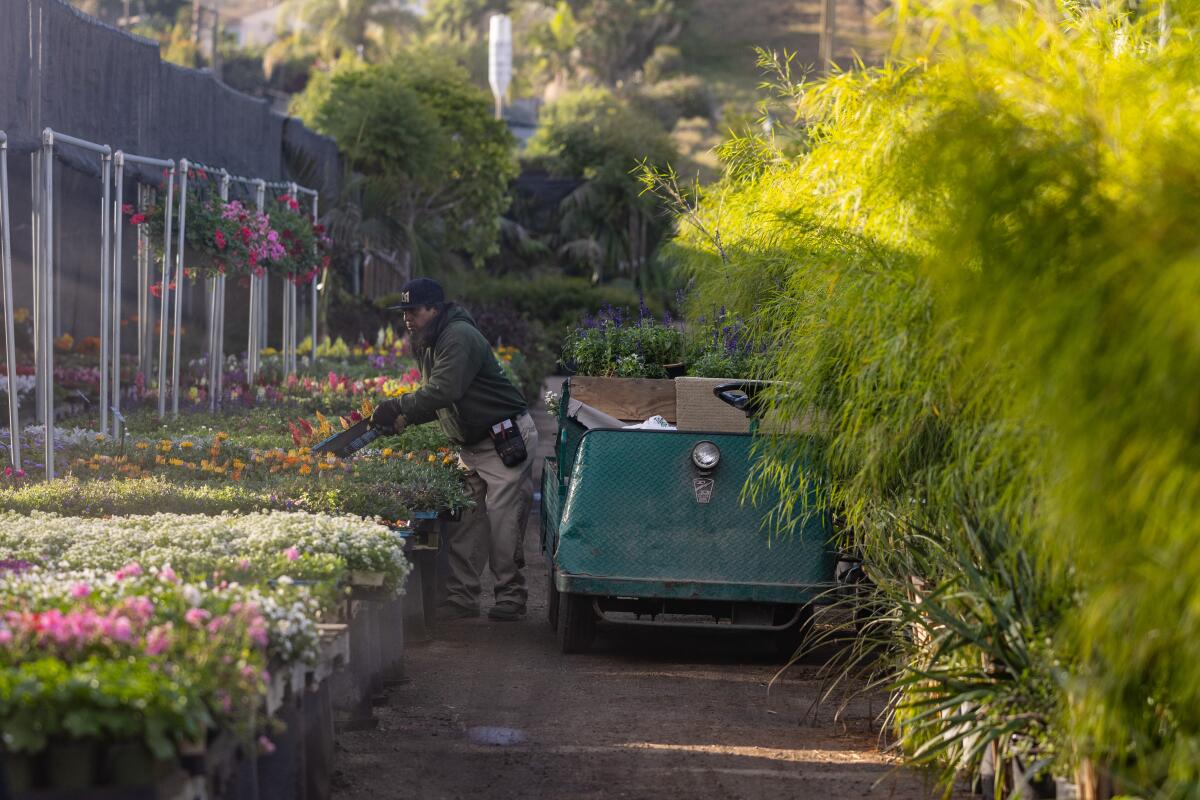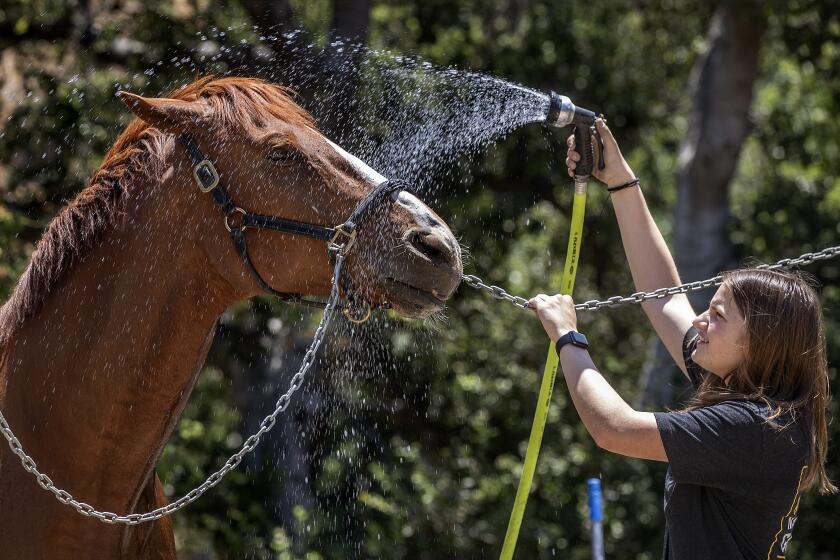Millions of sterile fruit flies are being dropped on L.A. to fight an infestation

- Share via
The citrus trees at C&S Nursery in Baldwin Hills would normally be full of passionfruit, kumquats and other fruits this time of year. But last month, employees stripped dozens of them and placed them at the rear of the lot, away from the public, as part of an all-out quarantine effort aimed at eradicating one of the most destructive pests in the world: the Mediterranean fruit fly.
In addition to the fruit removal, ordered by Los Angeles County along with federal and state agencies, officials have a more dramatic plan in the works: dropping millions of sterile male flies on Los Angeles County over the next several weeks in hopes of disrupting the life cycle of the insects, which feast on a wide variety of fruits.
The operation was kicked off after the discovery of three Mediterranean fruit flies, or medflies, last month.
An employee with the Los Angeles County agricultural commissioner’s office found two adult flies caught in a trap attached to a persimmon tree and one on a pomegranate tree in a Leimert Park yard, according to authorities.
That spurred a quarantine order from the California Department of Food and Agriculture, covering what is now an 88-square-mile area that stretches north to Melrose Avenue, west to the 405 Freeway, south to the 105 Freeway and east to Soto Street, running through Huntington Park.

The quarantine covers produce from commercial growers, wholesalers and retailers in the area. Home gardeners are urged to consume or process their fruit only at home and not move it from their property, or dispose of it by double-bagging and placing in the regular trash bin.
Within 200 meters of each detection of medflies, properties will be treated with an organic insecticide, and within 100 meters of each detection of larvae or multiple adults, fruit must be removed from trees.
At C&S Nursery in Baldwin Hills, citrus trees did not show signs of the pests, but the business is required to de-fruit its trees and cannot sell those that could play host to the flies, according to co-owner Santiago Rosales Sr.
Rosales worries the quarantine could stretch into spring, hurting his sales; he estimated a loss of $20,000 each month the business is unable to move its citrus plants and trees.
“There are a lot of unanswered questions at this point about what happens next,” Rosales said.

Co-owner Chris Rosales said C&S Nursery was “first told it would be a 30-day quarantine and now it might be 100 days.”
“Now we’re investing more money into maintaining our citrus trees,” he said. “Customers call and ask if we have any, but I can’t sell them to anyone.”
Nurseries and other businesses that enter into compliance agreements with the county will be informed when the quarantine is lifted, and the sale of citrus plants could continue under certain conditions, said Ken Pellman, a spokesperson for the L.A. County agricultural commissioner’s office.
As for the hordes of sterile male medflies soon to be dropped over the area, each week more than a quarter-million flies will be airdropped per square mile in a 9-square-mile area around the infestation, according to the California Department of Food and Agriculture.
The drops will repeat every three to four days for two medfly life cycles, which typically last four to six months, dependent on the weather, according to officials.
The mud snails, which resemble grains of sand, could pose a threat to the highly protected Lake Tahoe ecosystem.
“An ounce of prevention is worth a pound of cure,” Pellman said. “So far, these methods have been great at eradicating exotic flies.”
The aerial drops alone would not be enough to eradicate fruit flies, said UC Davis entomology professor James Carey, who has studied medflies since 1980 and was on the California Department of Food and Agriculture’s medfly scientific advisory panel from 1987 to 1994. That’s why the quarantine measures are needed.
Though the aerial drops will flood the region with sterile male flies that can disrupt the population’s growth, it can be difficult to gauge how effective the process is if fly traps are swarmed with flies, Carey said, noting that fighting such infestations is an especially arduous battle in California.
“Nowhere in the world are fruit fly invasions as frequent, recurrent, persistent, continuous, contiguous, widespread, and taxonomically diverse as those that have occurred in California,” Carey said in an email.

After fruit flies made an abrupt appearance in California in the 1950s, they have remained entrenched here despite decades of eradication programs, according to a study co-authored by Carey in the Proceedings of the Royal Society B.
Just this year, Los Angeles weathered another fruit fly infestation in August, after 30 Tau flies — originating in Southeast Asia — were discovered in Stevenson Ranch, spurring the first known quarantine for the insect in the Western Hemisphere. The flies probably arrived in Southern California from overseas via a shipment of produce or other products, according to officials.
The latest quarantine follows a playbook that has been used before.
It’s the first quarantine in the Western Hemisphere for the tau fruit fly, a serious pest with a wide host range that includes numerous fruits and vegetables.
In 1980, state and federal agencies mounted an eradication operation after an outbreak of medflies in the Santa Clara Valley southeast of San Francisco. That operation saw aerial drops of sterile flies but also men tossing out “fried chicken buckets” full of flies from the backs of slow-moving pickup trucks, according to the U.S. Department of Agriculture.
That initial phase was ineffective and was followed by de-fruiting trees, drenching the soil to kill the larvae and releasing more sterile flies.
Millions of cars were stopped to check for fruit and plants, according to the USDA, and there was even a “worm watch” public service announcement released to watch for larvae activity. The operation eventually spread across 3,000 square miles and parts of six counties and lasted for more than two years.
More to Read
Sign up for Essential California
The most important California stories and recommendations in your inbox every morning.
You may occasionally receive promotional content from the Los Angeles Times.
















